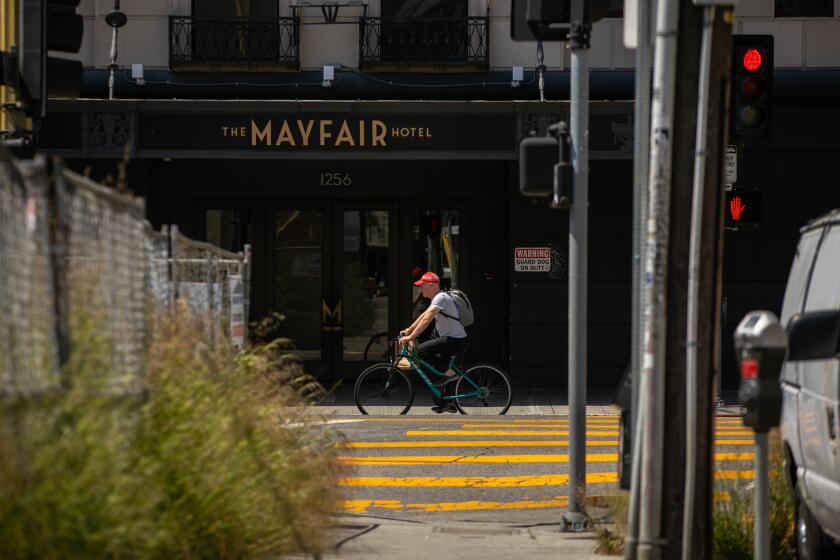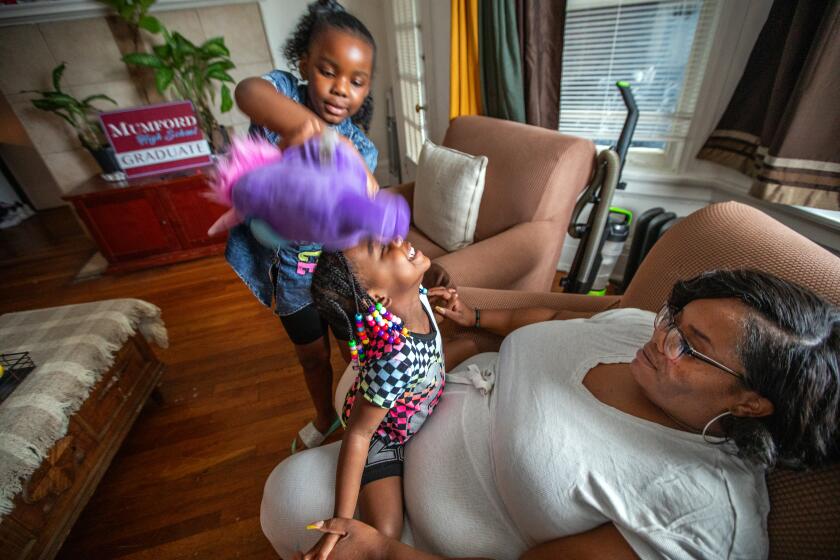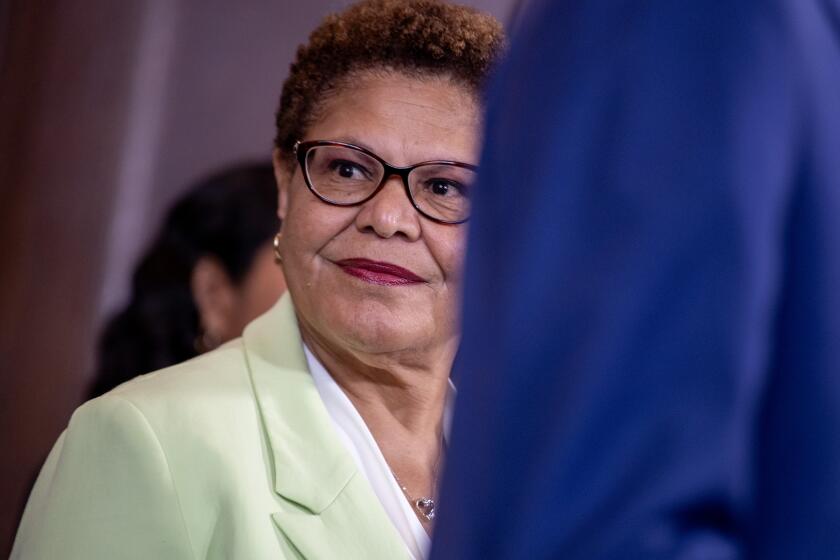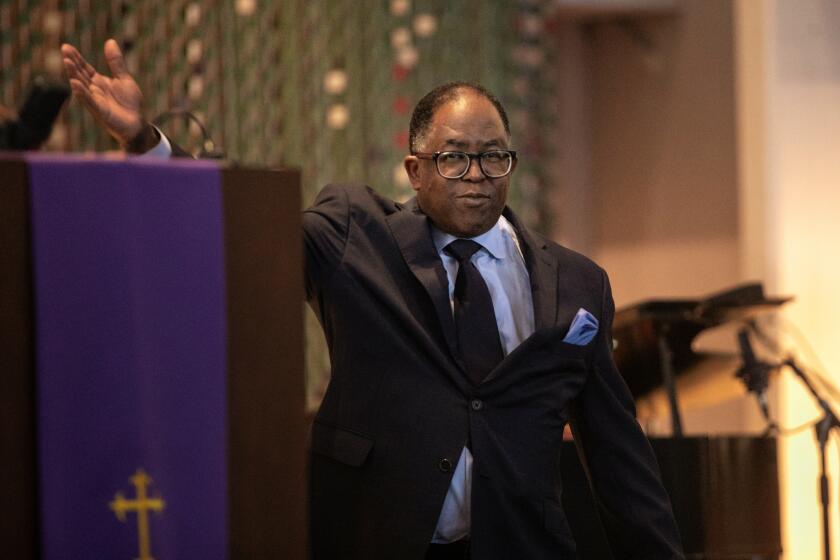An L.A. hotel became homeless housing. The city paid $11.5 million to cover the damage
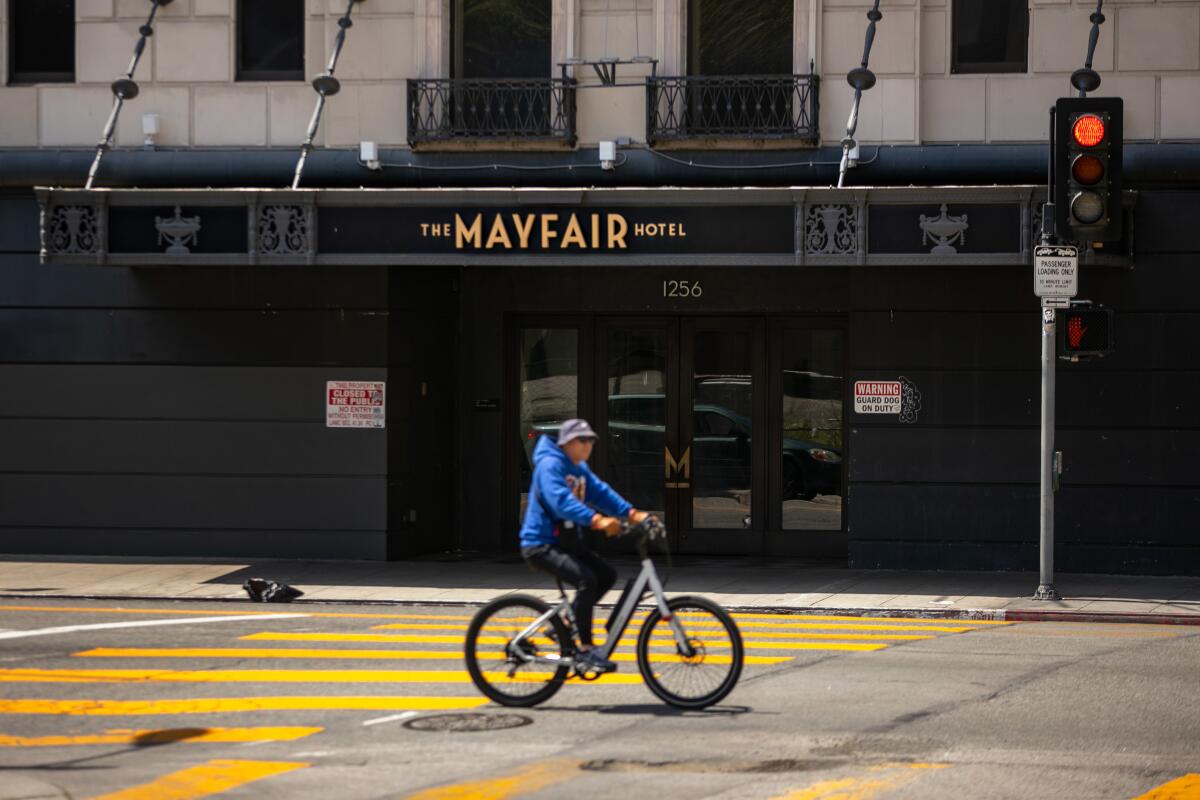
By the time the Mayfair Hotel shut its doors last year, the building had been through a wrenching, tumultuous period.
Windows at the 294-room boutique hotel, in L.A.’s Westlake neighborhood, had been shattered. Bathrooms had been vandalized. In some locations, carpet had been torn off the floor.
“Participant in 1516 Threatened staff, Security, destroyed property. Screamed. Yelled cursed. Everything went wrong with her. Inside and outside the building,” wrote a worker with Helpline Youth Counseling Inc., a service provider assigned to the hotel, in early 2022.
Those and other incidents were described in emails sent to the city of Los Angeles during the final six months of the Mayfair’s participation in Project Roomkey, a federally funded initiative that transformed hotels across L.A. into temporary homeless shelters. The emails, copies of which were obtained by The Times, depict a staff of security guards, nurses, hotel managers and others grappling with drug overdoses, property damage and what they characterized as aggressive and even violent behavior.
“Around 10 am a male in 1526 assaulted another resident in Room 726,” a security guard wrote in March 2022. “The situation was quickly broken up and 1526 was escorted out by police.”
The city has quietly paid the hotel’s owner $11.5 million in recent months to resolve damage claims filed over Project Roomkey.
Bass and her homelessness team have spent months working on the acquisition of the Mayfair so that it can be used for her Inside Safe initiative as “permanent” interim housing.
Now, Mayor Karen Bass wants the city to purchase the Mayfair and convert it into homeless housing once again. But this time, residents, merchants and property owners are pushing back, saying they don’t want a return of the conditions they say they encountered when the Mayfair took in unhoused residents from Echo Park, Koreatown and other areas.
“The neighborhood is still recovering from Project Roomkey,” said Ruben Lares, who lives across from the hotel. “The purchase of the Mayfair would just completely destroy the community once again.”
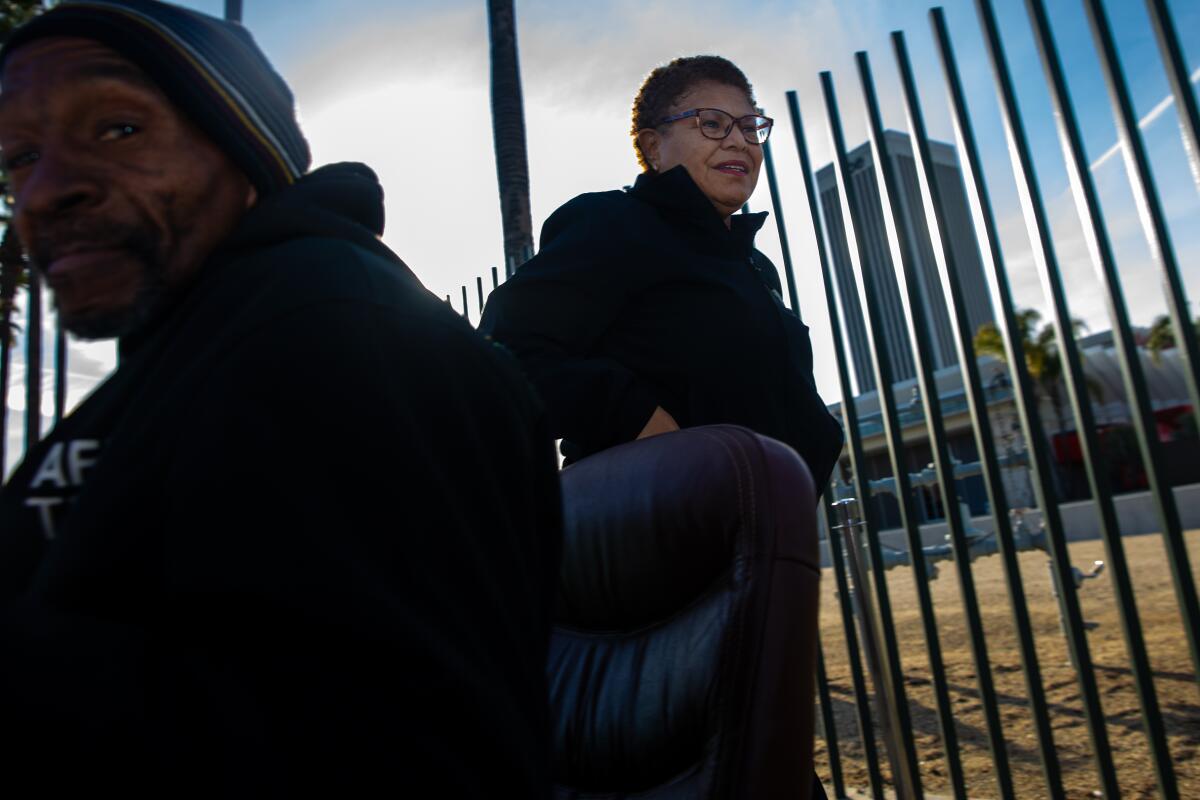
Bass and her team have been trying to reassure the neighbors, promising the Mayfair will be “completely different” from Project Roomkey once it is city-owned. Project Roomkey, she said, was created in response to COVID-19, providing rooms for unhoused Angelenos to shelter in place but lacking in critical social services.
“We’re going to put in the time and the effort so that the residents in the nearby area understand that this is going to be a different program,” Bass said in an interview.
The City Council is scheduled to vote on the purchase Friday, paving the way for the city to spend more than $83 million on acquisition, renovation and upgrades to the Mayfair, a figure that is on top of the money paid in damage claims.
In the 48 hours leading up to the vote, the Mayfair proposal is slated to go before three council committees — one devoted to homelessness, another dealing with government operations and a third focused on the city budget. Councilmember Eunisses Hernandez, who represents the area, has declined to take a stance on the project, saying she is still evaluating it and taking input.
The public tends to blame homelessness on poverty, drug use, crime or warm weather. But other cities don’t have L.A. levels of homelessness. They have more housing.
“Her priority remains advancing housing solutions that will offer sustainable, dignified solutions to our homelessness crisis,” Hernandez spokesperson Chelsea Lucktenberg said.
Bass intends to use the Mayfair as part of Inside Safe, her initiative to move unhoused residents into hotels and then into permanent housing. Buying the Mayfair, she said, would substantially reduce the program’s room rental costs.
Under the proposal, unhoused residents would be relocated from Skid Row and other areas and placed in the Mayfair, where they would receive on-site case management and extensive social services. The hotel would offer mental health specialists, addiction counselors, nurses, activities and rules that teach residents “how to be a good neighbor,” said Mercedes Marquez, the mayor’s homelessness czar.
The “focus is on transforming people, stabilizing folks, so that they can go on and live in permanent housing,” she said. “In order to do that, residents have to learn how to contain themselves, how to be able to monitor themselves.”
Whether those arguments will win over the neighbors is far from clear.
Mayor Karen Bass has gotten a big ask from the U.S. Dept. of Housing and Urban Development, which has agreed to allow LA to put homeless people into housing before they compile all the documentation necessary to prove their eligibility.
On Saturday, residents and business owners at a town hall meeting vented for more than an hour about conditions they say were present during Project Roomkey, a program that was created during the administration of former Mayor Eric Garcetti and ended at the hotel in July 2022. They described scenes of open-air drug use, discarded hypodermic needles, antisocial behavior and criminal activity.
One woman who worked nearby as a cashier during the pandemic said people regularly grabbed merchandise and ran out of her shop. Another person said his windshield was smashed with a crowbar.
Darlene Adderison, who lives near the Mayfair, said hotel residents repeatedly played music outside her building that boomed so loud it drowned out her television. She said she told them to turn it down, only to be cursed at.
“I don’t want them back in this neighborhood,” she said. “I want my peace. I am 66 years old and I want my peace.”
For some neighbors, the promise of rules at the Mayfair provides little solace.
Businessman Angat Gaada said rules prohibiting drugs in the hotel during Project Roomkey spurred Mayfair residents to consume them out on nearby sidewalks instead. Hotel residents regularly sneaked into his family’s apartment building and used drugs in the stairwell and parking garage, setting off fire alarms, Gaada said.
“The rules were only enforced within the Mayfair. They weren’t enforced outside of the Mayfair,” he said.
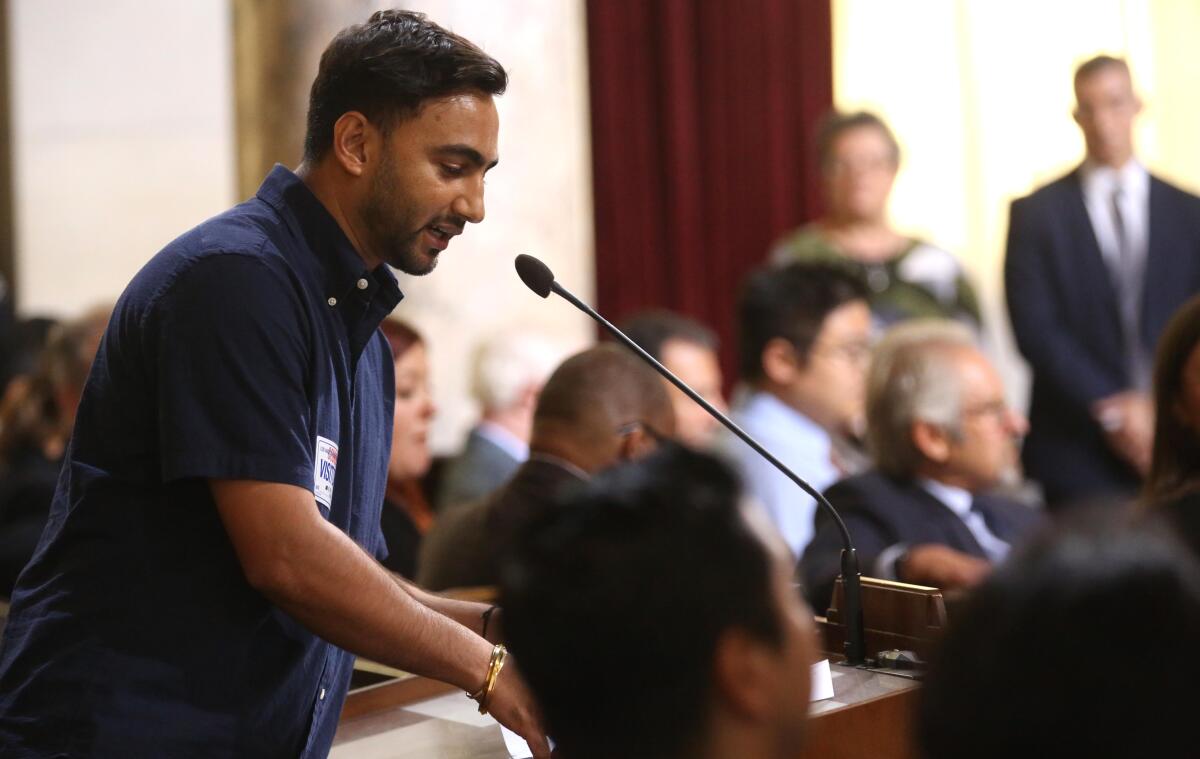
Things were also difficult inside the hotel, according to emails sent to the city. Workers regularly encountered damage to the building, which had been the subject of an extensive renovation a few years earlier.
In Room 406, hotel managers found two broken windows, a broken television and a broken granite countertop. In Room 504, they found that a resident had spray-painted the shower curtain, written on a bathroom mirror and stained the carpet with spray paint. In Room 801, someone smeared feces around a doorway.
“Room needs bio cleaning,” Anthony Hernandez, a hotel manager, wrote after that incident.
Mayor Bass said some who left Inside Safe have chafed at the rules imposed inside the program’s hotels, while others struggled with addiction or mental health.
One Mayfair resident punched a hole in a wall in the lobby, according to the correspondence. Another left a “hidden” candle burning in their room, igniting a fire that triggered a response from firefighters.
Staffers at the Mayfair attempted to keep tabs on substance use, with nurses administering Narcan and security guards working to keep contraband from entering the building. While some Project Roomkey participants expressed anger over those rules, others ignored them.
Get the lowdown on L.A. politics
Sign up for our L.A. City Hall newsletter to get weekly insights, scoops and analysis.
You may occasionally receive promotional content from the Los Angeles Times.
Hernandez reported that a resident in Room 508 acted violently, screaming in a housekeeper’s face. “Participant was upset claiming housekeeper took marijuana from his room even though housekeeping staff had not entered room,” his message said.
At another point, a nursing staffer expressed concern about “sheets of tinfoil” used to consume fentanyl scattered throughout one of the rooms. “It’s like this every day,” he said.
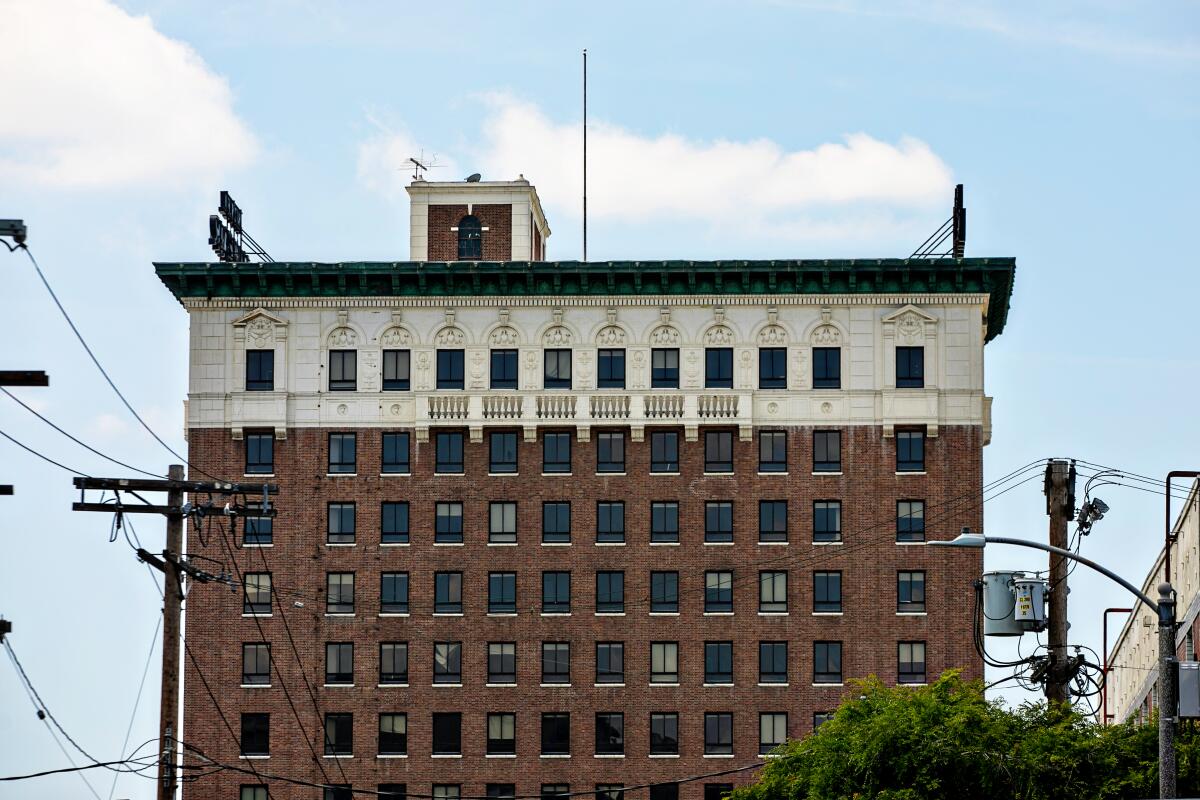
As the Project Roomkey program entered its final months, program staffers faced yet another problem: objects being hurled from windows. In May 2022, one employee warned that a piece of glass above the lobby had been shattered and could “completely break at any moment.” Residents had “continually thrown items out of their windows over the glass window in the lobby area,” the employee wrote.
“We are hoping all windows in the hotel can be locked again so this issue doesn’t continue,” the worker said in the email.
A month later, a security staffer reported that a vase had been thrown from a 10th-floor window. After sweeping up the glass, another vase came crashing to the ground, according to his report.
Jeff Farber, executive director of Helpline Youth Counseling, which was assigned to the Mayfair for roughly a year, defended Project Roomkey, saying it provided critical services. It gave emergency shelter to people who had not been housed in several years, some with serious mental health or substance use issues, and worked to keep them from contracting COVID-19, or help them recover when they did, Farber said.
Many had serious health conditions, he said.
“You’ve got to look at the fact that we kept people alive,” Farber said. “If they had been living on the streets [during the pandemic], there is a high probability they would not be walking around today.”
Farber said his group worked to connect Mayfair residents with the Department of Mental Health and other county agencies. He also expects services at the Mayfair to be much more extensive under Bass’ program.
More to Read
Sign up for Essential California
The most important California stories and recommendations in your inbox every morning.
You may occasionally receive promotional content from the Los Angeles Times.
